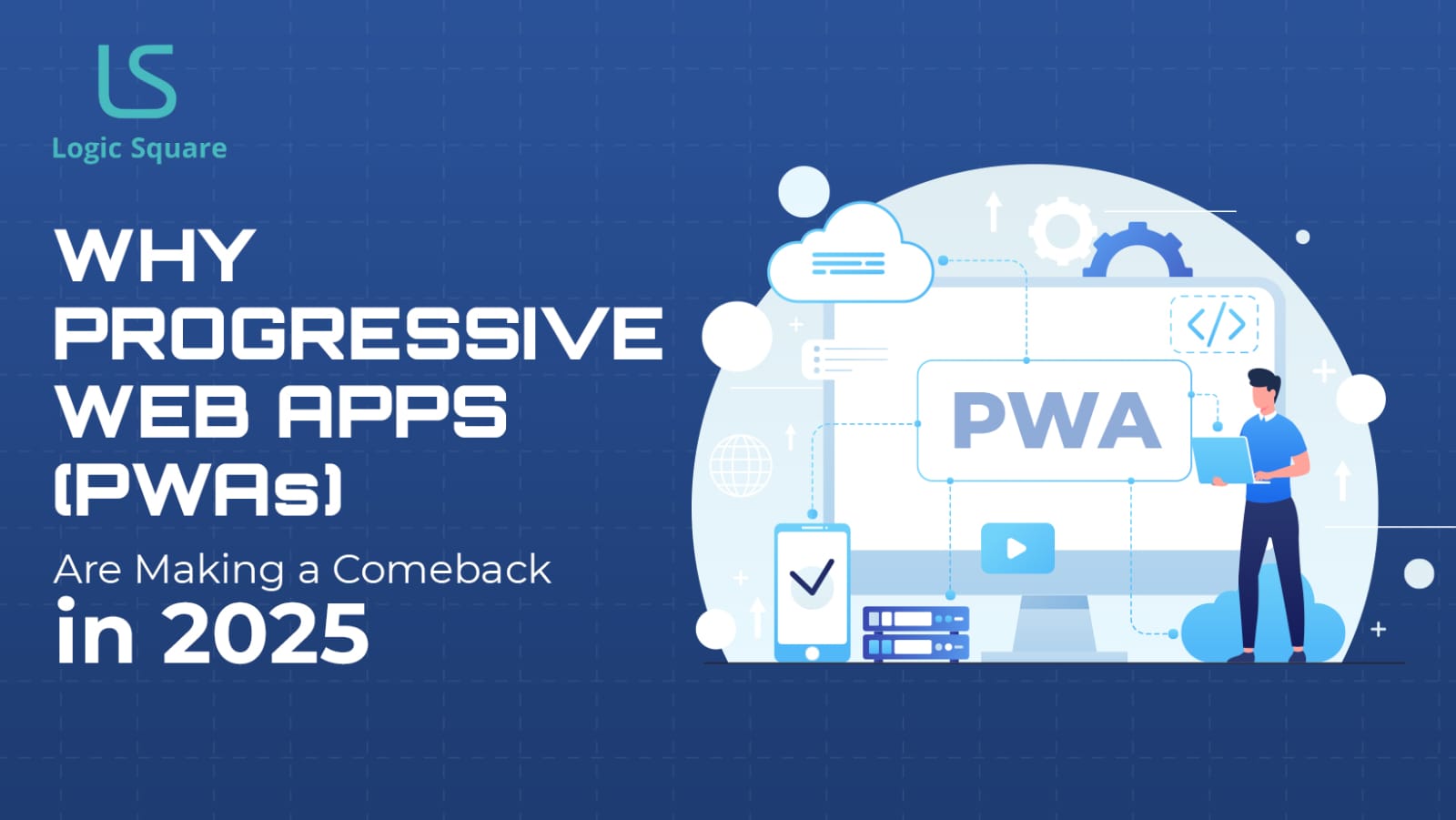Progressive Web Apps (PWAs) have long promised a unified solution, combining the reach of the web with the capabilities of native apps. Yet for years, their potential remained largely untapped due to platform limitations, especially on iOS.
Table of Contents
ToggleIn 2025, that has finally changed.
With Apple’s release of iOS 17 and macOS Sonoma, PWAs now receive first-class support on iPhones, iPads, and Macs. Install prompts, offline access, and push notifications, once restricted or completely unavailable, are now fully functional in Safari. This long-awaited update from Apple removes the biggest barrier to widespread adoption.
Now, rather than being a workaround or fallback, PWAs are emerging as a primary strategy for digital experiences across startups, enterprises, and everything in between.
What Is a PWA? (Quick Refresher)
A Progressive Web App is a web-based application that offers app-like functionality directly through a browser. Built with standard web technologies like HTML, CSS, JavaScript, and increasingly WebAssembly, PWAs provide users with fast, installable, offline-capable experiences across all devices.
Key components include:
- Service workers to manage caching, offline capabilities, and background sync
- Web app manifest to define the app’s icon, theme, and install settings
- HTTPS is used by default for secure communication
- Home-screen install support to offer native-like access from the user’s device
In practice, PWAs blur the lines between websites and native apps, offering the accessibility of the web and the functionality of mobile software.
Why 2025 Is the Turning Point for PWAs?
Several key developments have converged in 2025, making this the year that PWAs truly step into the mainstream.
a) Apple Opens the Gates
Until recently, iOS severely limited what PWAs could do. But with iOS 17 and macOS Sonoma, Apple has unlocked key functionality, including:
- Native install prompts within Safari
- Support for push notifications and background sync
- Full offline capabilities
This represents a major shift in platform behavior. With these features now available across Apple devices, PWAs offer consistent cross-platform experiences without the need for native app development.
b) Mature Tooling and Modern Web APIs
The ecosystem supporting PWAs has evolved significantly. Tools like PWABuilder now make it easier than ever to scaffold, audit, and deploy production-grade PWAs with advanced capabilities, such as:
- Biometric authentication integration
- Machine learning support for intelligent UIs
- Real-time performance diagnostics
- Voice and gesture interaction APIs
In parallel, advancements in Web Assembly have pushed the performance ceiling much higher. Complex applications that traditionally required native code—such as collaborative design tools or data visualization platforms can now run fluidly in the browser with near-native speed.
This has changed the conversation around PWAs in both custom mobile app development and software development more broadly. Instead of being viewed as a compromise, PWAs are increasingly seen as a viable, efficient, and scalable approach to delivering app functionality.
Teams now have the tools to build feature-rich web apps without sacrificing quality, while benefiting from the simplicity of a single codebase.
c) Market Pressures Favor PWA Adoption
Organizations in 2025 face growing demands for agility, cost-efficiency, and global reach. Businesses need to build apps quickly, deploy them across devices, and support users in diverse network environments—all while staying within budget.
PWAs deliver on all fronts:
- Fast development cycles
- No dependency on app store approvals
- Native-like functionality across devices
- Lower total cost of ownership
Whether you’re a startup launching an MVP or an enterprise rolling out internal field tools, the case for PWAs is more compelling than ever.
Core Advantages That Make PWAs Irresistible in 2025
PWAs offer a set of benefits that are difficult to match with native-only approaches.
Speed and Performance
PWAs leverage smart caching and background sync, allowing them to load quickly even on low-bandwidth connections. This makes them particularly valuable in regions with inconsistent internet access.
Offline Support
Service workers allow PWAs to function offline or in poor network conditions—ideal for field workers, travelers, or remote users.
One Codebase, Lower Costs
A single PWA can run on the web, Android, and iOS, reducing development and maintenance costs by up to 70 percent. This dramatically simplifies software lifecycles and resource allocation.
No App Store Friction
PWAs can be distributed instantly via URLs, bypassing app store approval processes, fees, and platform-specific restrictions.
SEO and Discoverability
Unlike native apps, PWAs are indexed by search engines and easily shareable. This improves discoverability and contributes to organic user acquisition.
Security and Trust
Built on HTTPS, PWAs ensure encrypted connections and support modern security features such as biometric authentication, secure storage, and user permission prompts.
Real-World Adoption and Results
Some of the world’s most recognizable brands have already demonstrated the effectiveness of PWAs:
- Twitter Lite increased pages per session by over 60% and reduced bounce rates dramatically
- Pinterest saw a 44% increase in user-generated ad revenue and a 40% rise in engagement
- Starbucks rolled out a PWA that allowed users to browse menus and place orders offline, while using significantly less storage
- Forbes reported improved engagement metrics, including a tripling of scroll depth and session duration
In the enterprise world, internal tools are also going PWA. Field service apps, inventory systems, and logistics dashboards are being rebuilt as PWAs, saving companies thousands in device costs and reducing dependency on native development teams.
Lessons and Caveats: What Developers Are Saying
Despite their growing capabilities, PWAs still come with trade-offs.
- Performance Variability: For extremely resource-intensive applications, native apps may still offer better memory and CPU efficiency.
- Browser Inconsistencies: While Chrome, Safari, and Edge now offer full PWA support, some platforms like Firefox desktop lag behind.
- Platform Strategy Conflicts: Major app store operators remain hesitant about promoting PWAs, as they bypass traditional monetization channels.
Understanding these limitations is essential when deciding whether a PWA is the right fit for a given use case.
Future Trends to Watch
PWAs will continue to evolve beyond their current capabilities, driven by emerging web standards and user expectations.
- AI-Driven Offline and Predictive UIs
Expect more apps to use AI for content preloading, offering personalized and seamless offline experiences. - Immersive Interfaces with WebXR and AR/VR
PWAs will increasingly support gesture-based and spatial interaction using WebXR, enabling new possibilities in education, retail, and gaming. - Secure Client-Side Storage and Industry Adoption
Sectors like finance, healthcare, and logistics are turning to PWAs for mission-critical apps. Secure storage options like IndexedDB, OPFS, and Web Cryptography APIs enable sensitive data handling directly in the browser.
Practical Guidance: When and How to Choose a PWA
PWAs are ideal for:
- MVPs or rapidly evolving products
- Content-driven platforms such as news, blogs, or streaming sites
- E-commerce and fintech apps
- Internal tools for distributed teams or field operations
Before you start, use this checklist:
- Identify which native APIs you require and evaluate web-compatible alternatives
- Plan for offline-first usage with service workers and sync logic
- Use WebAssembly or AI/ML where needed to boost performance
- Conduct cross-browser testing and implement fallback features for partial support environments
Why PWAs Are Here to Stay
Progressive Web Apps in 2025 are no longer an experimental option, they are a strategic decision.
With platform-wide support, powerful new web APIs, and a simplified deployment model, PWAs now offer a serious alternative to native apps in many contexts. Businesses looking to scale efficiently and reach users across devices without getting caught in the complexities of app store ecosystems are turning to PWAs as a smart solution.
For startups, enterprises, and agencies alike, the convergence of performance, accessibility, and cost-effectiveness means PWAs can no longer be ignored. Whether you’re focused on custom mobile app development or broader software development, PWAs should be part of your roadmap.
The comeback is real, and it’s just getting started.





